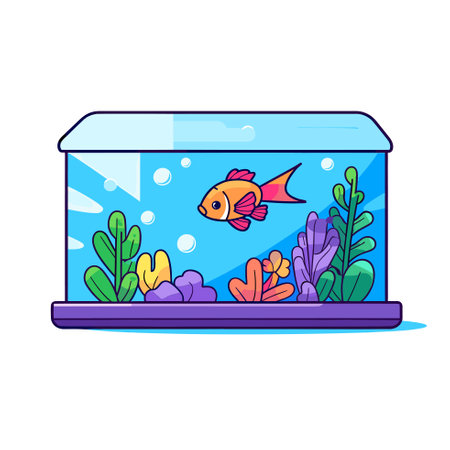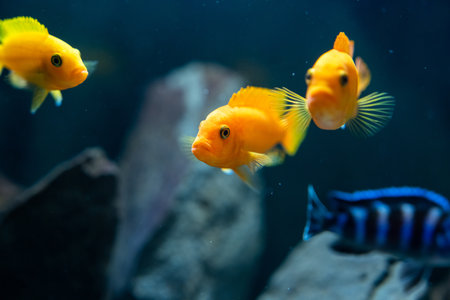1. Understanding the Importance of Water Quality
Maintaining pristine water quality is at the heart of successful fishkeeping in any UK home aquarium. Good water quality doesn’t just keep your tank looking crystal clear—it directly impacts the health, happiness, and longevity of your aquatic pets. Just as we wouldn’t want to live in a polluted environment, fish and invertebrates rely on clean, balanced water to thrive. In the UK, where tap water can vary in hardness and pH depending on your location, understanding local water parameters becomes especially vital. Regular testing for ammonia, nitrite, nitrate, and pH forms the foundation of responsible fishkeeping here. Additionally, many UK aquarists embrace practices such as weekly partial water changes and careful monitoring of temperature—habits that help mimic natural conditions and support a stable ecosystem within the tank. By prioritising water quality from the start, you’re not just ensuring your aquarium looks beautiful—you’re safeguarding the wellbeing of your finned friends for years to come.
Testing Your Aquarium Water
Maintaining pristine water quality in your UK home aquarium starts with regular and accurate water testing. It’s crucial to monitor key parameters such as ammonia, nitrite, nitrate, pH, and hardness—each of which can fluctuate due to local tap water variations and the specific needs of your fish species. Here’s how you can test your tank water effectively and interpret the results for the best care.
Choosing a Reliable Test Kit
You’ll find a variety of test kits available at local aquatic shops such as Maidenhead Aquatics or through reputable online retailers like Swell UK. Liquid reagent kits are typically recommended for their accuracy compared to test strips. When selecting a kit, ensure it covers all essential parameters relevant to British tap water, including general hardness (GH) and carbonate hardness (KH).
Key Water Parameters to Test
| Parameter | Ideal Range | Why Its Important |
|---|---|---|
| Ammonia (NH3) | 0 mg/L | Toxic to fish even at low levels; indicates waste breakdown issues. |
| Nitrite (NO2) | 0 mg/L | Toxic; shows whether the filter is converting ammonia properly. |
| Nitrate (NO3) | <40 mg/L | High levels stress fish; keep low with water changes. |
| pH | 6.5–8.0 (species-dependent) | Affects biological processes; varies by region in the UK. |
| GH/KH | Varies by species; check kit guide | Impacts stability and suitability for certain fish types. |
Sourcing Testing Kits Locally in the UK
You can purchase comprehensive test kits from high-street pet stores, aquatics specialists, or order online for home delivery. Some local shops offer free water testing services—handy if you’re unsure about conducting tests yourself or want a second opinion on your results.
How to Interpret Your Results
If you spot elevated ammonia or nitrite levels, immediate action is required—a partial water change and checking your filtration system are good starting points. Consistently high nitrates indicate it’s time to increase the frequency of your water changes or review stocking levels. For pH and hardness, it’s worth noting that British tap water varies greatly between regions—London tends to be hard and alkaline, while areas like Scotland often have softer, more acidic water. Adjustments may be needed based on the fish you keep; always acclimatise new arrivals carefully.

3. Water Changes: Frequency and Best Practices
Regular water changes are the backbone of maintaining a healthy aquarium, especially in the unique context of UK tap water. As a general rule, most UK aquarists benefit from changing 10-20% of their aquarium water weekly. This routine helps to dilute harmful waste products, replenish essential minerals, and maintain a stable environment for your aquatic residents.
Understanding UK Tap Water
The quality of tap water can vary significantly across different regions of the UK, with some areas having hard water rich in minerals like calcium and magnesium, while others supply softer water. Its important to test your tap water for pH, hardness (GH and KH), chlorine, and chloramine before using it in your tank. Investing in a good quality dechlorinator is essential—most UK tap water is treated with chlorine or chloramine, both of which are harmful to fish.
Best Practices for Stress-Free Water Changes
When carrying out water changes, try to match the temperature of the new water to that already in your tank. Sudden temperature shifts can be stressful for your fish. Add any conditioners or treatments to the replacement water before introducing it to your aquarium. Pour the new water gently—using a jug or siphon—so as not to disturb substrate or stress your fish.
Tips from UK Fishkeepers
Consider using a bucket dedicated solely for aquarium use to avoid contamination from cleaning products. Many seasoned UK aquarists also recommend preparing replacement water a few hours ahead of time; this allows any remaining chlorine to dissipate further and gives you time to test parameters one last time. If youre in a hard water area but keep soft-water species like tetras or discus, you might blend tap water with reverse osmosis (RO) water to achieve ideal conditions.
By adopting these best practices, youll ensure each water change supports the health of your aquarium—keeping your fish happy and stress-free while making maintenance manageable and rewarding for you as well.
4. Controlling Ammonia, Nitrite, and Nitrate Levels
Maintaining safe levels of ammonia, nitrite, and nitrate is crucial for the health of your fish and the overall stability of your aquarium. In the UK, tap water can vary significantly in terms of hardness and chemical content depending on your region—so its essential to tailor your approach to local conditions. Regular testing with a reliable aquarium water test kit will allow you to monitor these key toxins closely. Below is a guide to acceptable levels and recommended actions if readings are high:
| Substance | Safe Level | Action if High |
|---|---|---|
| Ammonia (NH3) | 0 ppm | Immediate partial water change (25-50%), check filter efficiency, avoid overfeeding |
| Nitrite (NO2-) | 0 ppm | Partial water change, add beneficial bacteria supplement, ensure good aeration |
| Nitrate (NO3-) | <40 ppm (preferably <20 ppm for sensitive species) | Regular water changes, live plants introduction, reduce feeding quantity |
Testing Frequency and Local Considerations
For most UK home aquariums, it’s wise to test ammonia and nitrite at least once per week, especially in new setups or after introducing new livestock. Nitrate should be checked fortnightly. In areas with hard water—common in much of southern England—biofiltration may be more robust due to higher pH and mineral content, but high nitrate from mains water can still be an issue. Consider using dechlorinated water or a nitrate-removing filter media if your tap water already contains elevated nitrates.
Bespoke Tips for UK Aquarists
- If you’re in a soft water area (such as Scotland or parts of Wales), monitor pH as sudden drops can inhibit your filter bacteria’s ability to process toxins.
- Avoid overstocking—a common pitfall in smaller British homes. Stick to recommended stocking levels to keep bioload manageable.
Caring for Your Aquarium Community
Your careful attention to these key water parameters helps build a thriving aquatic environment where fish can flourish. Remember: consistency is key—regular monitoring and small corrective actions will keep toxin levels in check and your tank community healthy.
5. Managing pH and Hardness
When it comes to maintaining a thriving aquarium in your UK home, understanding and managing the pH and hardness of your water is essential. UK tap water typically leans towards being slightly alkaline, with a pH often ranging from 7.0 to 8.0, and it can be moderately to very hard due to the natural geology of many regions. While this suits many popular fish species such as livebearers and some cichlids, it may not be ideal for all aquatic inhabitants.
Checking Your Water Parameters
Regularly test the pH and general hardness (GH) of your tank water using reliable test kits. This gives you a baseline to understand if adjustments are necessary for the species you keep. Many garden centres or aquatic shops across the UK offer free water testing services, which can be especially helpful if you’re just starting out.
Adjusting pH and Hardness
If you’re keeping soft-water species like tetras or discus, you may need to lower both pH and hardness. This can be done by mixing in reverse osmosis (RO) water, using peat moss in your filter, or adding commercial water softeners—always following manufacturer’s guidelines. Conversely, for hard-water loving species, crushed coral or limestone in your substrate or filter can help maintain stability.
Stabilising Levels
Sudden swings in pH or hardness can stress your fish, so always make changes gradually. When topping up or doing water changes, ensure that the new water is adjusted to match your aquarium’s established parameters as closely as possible. Consistency is key; regular small water changes are preferable over large infrequent ones.
Catering to Your Fish
Research the specific needs of your chosen fish species—many UK aquarists opt for hardy varieties that adapt well to local tap water conditions. If you have a community tank with mixed species, aim for a compromise within their preferred ranges rather than chasing perfection for one type at the expense of others.
By taking these steps and keeping an eye on your tank’s chemistry, you’ll create a stable and healthy environment where your aquatic pets can flourish in line with the unique qualities of UK tap water.
6. Filtration Systems for UK Aquariums
Choosing the right filtration system is crucial for maintaining a healthy aquatic environment in your UK home aquarium. A good filter not only removes visible debris but also supports essential biological processes that keep water parameters stable. When selecting a filter, always consider the size and type of your aquarium—whether it’s a compact nano tank or a spacious community setup, the filter must be able to handle the volume and bioload of your fish and plants.
Popular UK Brands and Product Choices
In the UK, trusted brands such as Fluval, Eheim, Aqua One, and Tetra are widely available at local aquatic shops and online retailers. For smaller tanks, internal power filters like the Fluval U Series or Aqua One Clearview are popular due to their ease of use and quiet operation. For larger aquariums, external canister filters such as the Eheim Classic or Fluval 407 provide superior mechanical, chemical, and biological filtration.
Maintenance Matters
No matter which brand or type you choose, regular maintenance is key. Rinse filter sponges or pads in old tank water every few weeks to remove waste build-up without destroying beneficial bacteria. Replace chemical media, such as activated carbon or ammonia remover, according to manufacturer recommendations—usually every four to six weeks. Always check impellers and hoses for blockages or wear, as these can reduce efficiency over time.
When to Upgrade Your Filter
If you notice cloudy water, persistent odours, or an increase in algae despite routine cleaning, it may be time to upgrade your filtration system. Consider moving up to a higher-capacity filter or adding supplementary filtration such as a sponge filter for additional biological support. Upgrading is especially important if you have increased your aquarium’s stock levels or changed from a coldwater to a tropical setup.
Ultimately, choosing and caring for the right filtration system will greatly enhance your success in maintaining water quality in your UK home aquarium. Regular checks and timely upgrades not only protect your fish but make keeping an aquarium more enjoyable and less stressful in the long run.
7. Preventing and Dealing with Algae
Algae can be a persistent challenge in UK home aquariums, but with some thoughtful care and understanding of local conditions, you can keep it under control. The UKs unique climate—with its long summer days and shorter winter daylight hours—can influence algae growth significantly. During the brighter months, natural light streaming through windows may encourage unwanted blooms, while the reduced sunlight in winter might slow things down but not eliminate the problem.
Understanding Local Factors
Algae thrive on light and nutrients. In the UK, fluctuating daylight hours mean that tanks near windows or conservatories might experience rapid algae growth as soon as spring arrives. Always position your aquarium away from direct sunlight to limit this risk. Seasonal changes also affect your central heating use, which can impact water evaporation rates and nutrient concentration—another factor in algae outbreaks.
Tips for Keeping Algae Growth in Check
Control Lighting
Use a timer to provide your fish with a consistent photoperiod—generally 8-10 hours of light per day is plenty. This not only mimics natural British daylight cycles but also helps prevent excessive algae growth caused by too much light exposure.
Regular Maintenance
Perform routine water changes and vacuum your substrate weekly. This removes excess nutrients that feed algae. Scrape any visible algae from tank walls with an algae magnet or scraper—these are widely available at most UK aquatic shops.
Choose UK-Available Remedies
If manual cleaning isn’t enough, consider introducing live plants such as Anubias or Java Fern, which outcompete algae for nutrients. Alternatively, adding a few locally sourced algae-eaters like Amano shrimp or Bristlenose Plecos can help keep things tidy without resorting to chemicals. Avoid over-the-counter algaecides unless absolutely necessary, as these can harm sensitive UK-native fish breeds and disrupt beneficial bacteria.
Monitor Water Quality
Test your water regularly using test kits readily available from UK pet shops. Keeping nitrate and phosphate levels low is key; high readings usually indicate it’s time for a water change or a review of your feeding routine.
Stay Adaptable with the Seasons
As the seasons shift, adjust your aquarium routines accordingly. For example, you may need to reduce lighting in summer or increase water top-ups in winter when evaporation is higher due to central heating.
By staying mindful of these UK-specific factors and using locally available solutions, you’ll create a stable environment where both your fish and your plants can thrive—while keeping unsightly algae well under control.


